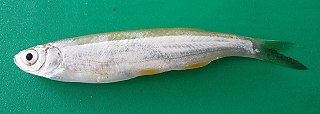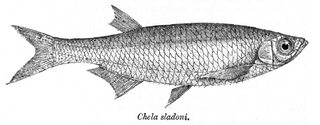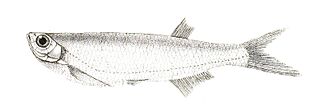
A tuna is a saltwater fish that belongs to the tribe Thunnini, a subgrouping of the Scombridae (mackerel) family. The Thunnini comprise 15 species across five genera, the sizes of which vary greatly, ranging from the bullet tuna up to the Atlantic bluefin tuna, which averages 2 m (6.6 ft) and is believed to live up to 50 years.

Mackerel is a common name applied to a number of different species of pelagic fish, mostly from the family Scombridae. They are found in both temperate and tropical seas, mostly living along the coast or offshore in the oceanic environment.

Herring are forage fish, mostly belonging to the family of Clupeidae.

The International Union for Conservation of Nature (IUCN) Red List of Threatened Species, also known as the IUCN Red List or Red Data Book, founded in 1964, is an inventory of the global conservation status and extinction risk of biological species. A series of Regional Red Lists, which assess the risk of extinction to species within a political management unit, are also produced by countries and organizations.

Wobbegong is the common name given to the 12 species of carpet sharks in the family Orectolobidae. They are found in shallow temperate and tropical waters of the western Pacific Ocean and eastern Indian Ocean, chiefly around Australia and Indonesia, although one species occurs as far north as Japan. The word wobbegong is believed to come from an Australian Aboriginal language, meaning "shaggy beard", referring to the growths around the mouth of the shark of the western Pacific.

The billfish are a group of saltwater predatory fish characterised by prominent pointed bills (rostra), and by their large size; some are longer than 4 m (13 ft). Extant billfish include sailfish and marlin, which make up the family Istiophoridae; and swordfish, sole member of the family Xiphiidae. They are often apex predators which feed on a wide variety of smaller fish, crustaceans and cephalopods. These two families are sometimes classified as belonging to the order Istiophoriformes, a group which originated around 71 million years ago in the Late Cretaceous, with the two families diverging around 15 million years ago in the Late Miocene. However, they are also classified as being closely related to the mackerels and tuna within the suborder Scombroidei of the order Perciformes. However, the 5th edition of the Fishes of the World does recognise the Istiophoriformes as a valid order, albeit including the Sphyraenidae, the barracudas.

An anchovy is a small, common forage fish of the family Engraulidae. Most species are found in marine waters, but several will enter brackish water, and some in South America are restricted to fresh water.

The silver razorbelly minnow Chela Maach in Bengali is a species of ray-finned fish in the carp family, Cyprinidae. It is native to India, where it occurs in many river systems. It has also been reported from Bangladesh.

The large razorbelly minnow is one of thirteen species of ray-finned fish in the genus Salmostoma.
Salmostoma balookee, the Bloch razorbelly minnow or Reddiah razorbelly minnow, is a species of cyprinid fish in the genus Salmostoma. It is distributed in India and Myanmar.

The boopis razorbelly minnow is a species of cyprinid fish in the genus Salmostoma. It is widespread throughout the Western Ghats of India
The Hora razorbelly minnow or Hora's razorbelly minnow is a species of ray-finned fish in the genus Salmostoma.

The finescale razorbelly minnow is a species of ray-finned fish in the genus Salmostoma. It is a species of freshwater fish native to Bangladesh and throughout India. It lives in the lower reaches of various bodies of water including rivers, canals, ponds, and ditches. With a maximum length of only 12 centimetres (4.7 in), the fish is of little commercial or dietary value to humans.

The Punjab razorbelly minnow is a species of ray-finned fish in the genus Salmostoma.

The Sardinella razorbelly minnow is a species of ray-finned fish in the genus Salmostoma. It occurs in the lower reaches of rivers in India, Bangladesh and Myanmar.

Salmostoma sladoni is a species of ray-finned fish in the genus Salmostoma.

The Mahanadi razorbelly minnow is a species of ray-finned fish in the genus Salmostoma.















